Back in early 2017 I made mention that my girlfriend and I had played through the first 4 episodes of Life is Strange and loved it but that our playthrough was “tragically” cut short before we could tackle episode 5. I talked about this a bit more here, but that original allusion was to a pretty shitty “real life” invasion into my gaming life. In the summer of 2016 my house was broken into and burglarized with my video game collection being one of the primary targets. Fortunately, I was in the process of moving at the time so most of my stuff had already been packed away and didn’t get touched, but one of the things that did disappear was my Xbox 360 which was still connected to my TV at the time. I wasn’t using cloud saves as my default save game storage back then so, worse than losing the console itself, I lost my entire history of Xbox 360 saves up to that point. Disheartened by the whole thing and not wanting to replay through almost the entire game in order to finish it, we regretfully put Life is Strange on the backburner.
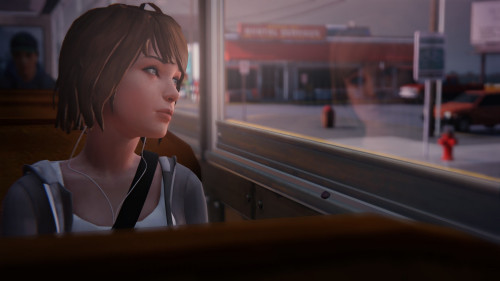
“Our protagonist, Max Caulfield.”
While we’d been eyeing all of the subsequent Life is Strange follow-up games like Life is Strange: Before the Storm and The Awesome Adventures of Captain Spirit with some curiosity, with the release of Life is Strange 2 this year we were finally hyped up enough to revisit the original game. This time around we took advantage of it being on Xbox Game Pass yet again and played the Xbox One version. Jumping in, we found that we both more or less remembered all of the first episode though our memories of specific details slowly began to fade as we progressed, culminating in the entirely unknown episode 5 and a satisfactory ending to the game at long last.
Broadly speaking, the game is a stripped down modernization of the classic graphical adventure game in a similar vein to Telltale’s post The Walking Dead games or Quantic Dream’s adventure games. That is to say, extremely narrative heavy with your choices being reflected in-game, giving an illusion of a complicated branching story. A lot of those choices take place via conversations, and there are also minimal, easy puzzles based on exploration along the way to round out the formula. In Life is Strange’s case, a lot of the puzzle solving involves the main character’s ability to rewind time, also central to the plot itself. There are some more traditional adventure game puzzles early on but, as with The Walking Dead: Season One, that approach is largely abandoned after the first episode.
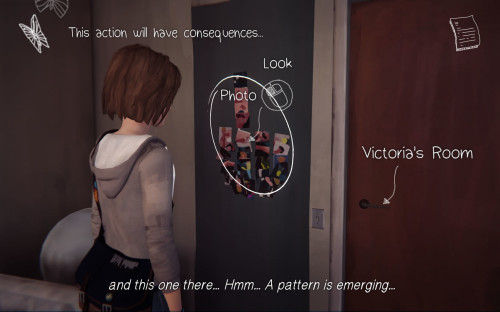
“Light, exploration-based adventure game stuff.”
Despite the similarities, Life is Strange does an admirable job of not coming off as some sort of a Telltale adventure game clone. Its systems don’t feel quite as obvious, at times feeling more like a “walking simulator” than an adventure game, and the total lack of QTEs or any sort of action gameplay goes a long way to helping. The game also supplements the already effective presentation with a phone text messaging system and an in-character log/journal system for even more exposition and depth.
The game starts off with your character, a teenage girl named Max, going about her day in a private school she’s recently transferred to after moving back to the town where she grew up. The mundanity of the high school drama quickly turns much more serious with a startling act of violence, the discovery of the aforementioned time manipulation powers, and an unexpected reconnection with Max’s childhood best friend, Chloe. Those (and other) inter-connected threads end up in a compelling balance of interpersonal drama and mystery with just a touch of the supernatural.
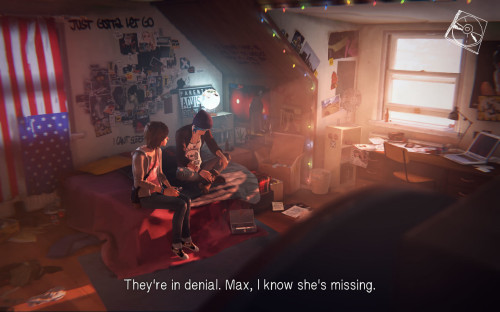
“The drama takes no time at all to kick in.”
The first episode is a little jarring to a lot of people as that’s where some of the game’s more infamous peculiarities are at their worst. Much has been made about the odd, stilted attempts to replicate teenage conversation which had so many people facepalming out of the game, the nonsensical description of Blackwell Academy as some sort of a prestigious art school that sounds like a private college (and indeed, most of the students are college aged) yet is referred to multiple times as a high school, and the sometimes annoying and unlikable personalities and behaviors of the main characters. While I don’t think any of those issues are anything to bail out of the game early over, a couple of them do warrant some further focus here, I suppose.
First, about the odd language that the characters, particularly Max and Chloe, use. Just about everyone seems to agree that it comes across as a little ridiculous and, at best, inauthentic. Some justify it as simply being the way teenagers actually talk, less us out of touch adults forget, while another common explanation is that Life is Strange’s developer, Dontnod, is French and likely even more out of touch about the way American high schoolers talk (which may also explain their lack of understanding about the American school system!) Regardless, this gradually improves as the season continues past the first episode, with the characters sometimes even seemingly jokingly referencing those earlier missteps. It’s no big deal even if it is sometimes incredibly silly.
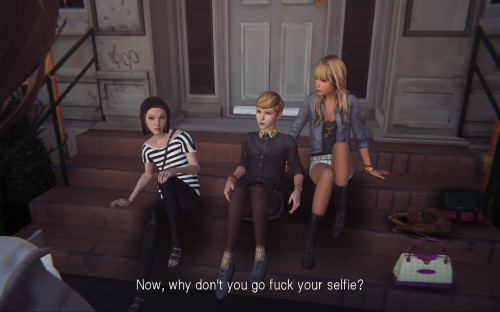
“The infamous ‘Go fuck your selfie!’ line. Oh, and fuck Victoria Chase!”
Directly related are the characters themselves. Personally, I find their personalities and motivations to be easy to believe. Chloe’s overly rebellious behavior and shitty, selfish attitude is fairly thoroughly justified. This is someone whose struggles with her emotions and her place in the world, already an issue for a lot of teenagers, are amped up to 11 by the trauma of losing her dad and then her best friend when she needed a support network the most. Max, on the other hand, comes across as someone spends far too much time in her own head and, while not incredibly awkward, sometimes comes across as a little shallow when she does decide to come out of her shell and interact with people. When she’s thrown into all of these crazy new situations she’s, of course, thoroughly unprepared to handle them. I’ve known plenty of people with similar personalities as both characters myself, in fact Max reminds me a bit of teenage me – the conclusions about how the world around me works, what is and isn’t cool, etc., forming my own private reality which I did a fairly terrible job of expressing. Honestly, there’s a certain amount of accepting that teenagers can be cringey and a little overly self-obsessed that needs to happen to truly “get” any of these characters. Sure, they can be annoying, but I feel like the people who absolutely hate this game because of the characters probably lack some perspective and maybe even a little empathy. Sorry!
More important than the personalities of the characters are the emotions they manage to convey, and this is where Life is Strange seems to make its improbable grand slam home run. The writing combined with excellent voice acting by the two leads really made the characters feel relatable and realistic, and their friendship (at least when coupled with the choices that I made in my playthrough) felt touchingly genuine. Combined with the intrigue of the plot, the game is astonishingly affecting and absorbing. By the end of the second episode I was totally hooked. From the reviews and impressions I’ve scanned, I believe I’m far from alone here in appreciating this particular aspect of the game as being uncommonly fantastic.
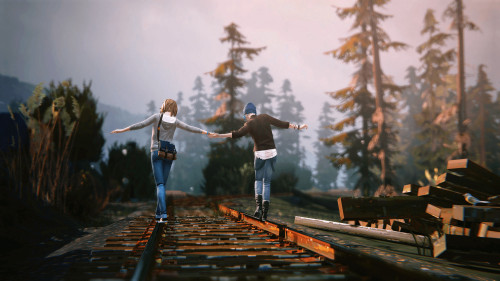
“Max and Chloe’s relationship steals the show.”
This is a complete package though. The interface is fairly intuitive and never really gets in your way. The graphics are mostly very good with the only real shortcoming being the character models, which are perhaps slightly more realistic than the game can really pull off, with faces and especially lip-syncing sometimes looking a little janky. I definitely feel like they should have leaned into the stylized approach just a bit more even if they didn’t want to go full Telltale. The soundtrack, save for a couple moments where the songs don’t quite fit the scene, is excellent. Not only does it work well with the perceived tone of the game, but it goes along way to helping set it. I had “Obstacles” by Syd Matters stuck in my head for days after finishing the game. It all feels reasonably polished too.
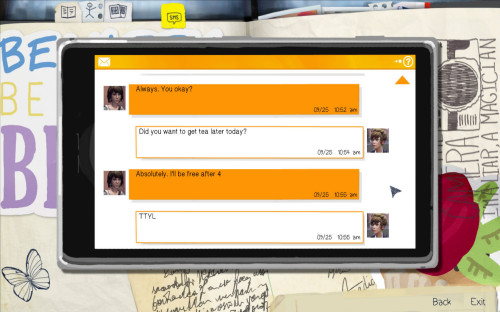
“Your text messages and your journal provide just a little extra exposition.”
So, after a few years we finally made our way back to (and through) the final episode. I wanted to talk a little bit about the end, and yes, I’ll spare anything but the vaguest of spoilers. Episode 5 culminates in some bizarre and disturbing time shenanigans, the resolution of at least one of our major plot points, and a big, dramatic decision. Not every potential loose end is wrapped up. You never receive any answers about the nature of Max’s powers, for instance. As that’s not really focus of the plot I can’t say it bugged me too much. It also ends up that quite a few of the details introduced in earlier episodes that seemed like they might be important never go anywhere. Regardless of whether these were plot threads that got abandoned as the series developed or they were purposely misleading “red herrings”, they added a lot of intrigue and mystery to the game.
I’ve also seen many more complaints about this last decision being a binary choice which does little to account for all of your previous choices up to that point. While sure, it does feel a little forced and limited, I don’t think it does anything to invalidate all of the choices you’ve made up until then. As I’ve said in the past in reference to Telltale’s games, the choices you’re making aren’t so much about affecting the overall plot as much as they are about affecting the details of the story, particularly when it comes to the actions and reactions of both playable and non-playable characters in the world. It’s less about changing the plot and more about customizing the particulars of it, with some entertainment value coming from standing back and observing the results.
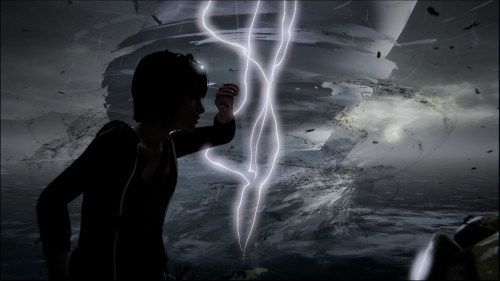
“The end times are here!”
Perhaps the oddest thing I’ve heard about the end (sometimes, but not always framed as a complaint) was that some players didn’t find Max’s relationship with Chloe to be compelling enough to make that final decision all that difficult. Since, as I mentioned, I found Max and Chloe’s friendship (we definitely read it as a close friendship, NOT romantic, by the way – interesting that such a potentially massive detail is so affected by your choices) to be one of the best parts of the game, this is quite hard for me to relate to. While I wouldn’t say the decision at the end was easy, both my girlfriend and I sided soundly in the same direction and were happy with the ending we got from it. Between that and the occasional complaint about plot holes I see, I’m fairly confounded by some people’s reads of this game. Maybe it’s a lack of empathy or any sort of ability to emotionally connect to a game on the part of some players, like I suggested earlier, or perhaps the differences caused your decisions along the way were greater than I realized.
Regardless, I loved Life is Strange and easily recommend it to those who like newer narrative adventure games and classic adventure games alike. Providing you’re able to fight your way through the all of cringey teenage dialog and drama, I think you’ll end up liking it. As for us, we already have the game’s follow-up prequel, Life is Strange: Before the Storm, installed and ready to start in the coming weeks.
As usual, these screenshots were liberally stolen from numerous places on the Internet. Most of them are from the PC version rather than the Xbox One version, but whatever. Also, the color palette isn’t quite this boring, and Max doesn’t only have one outfit – most of these shots were from the first episode to avoid spoilers!